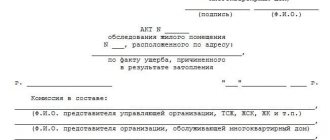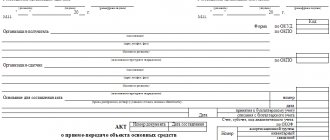Purpose of KS-10
In a situation where there are any buildings, plantings and other objects on a plot of land that impede future construction or other similar work, and they need to be demolished, an act on the assessment of buildings, structures and plantings subject to demolition is used. Objects are moved or demolished in agreement with their owner, who, in turn, receives material compensation for them. This is precisely what is assessed using the paper in question.
The document is necessary specifically for the owner of the property subject to demolition, since it will contain all the specifics of calculating compensation. This form is required for accounting purposes.
Basic documentation for safe demolition of a building?
The main documentation for the safe demolition of a building includes PPR and POR. The demolition project or DPR is one of the main documents for dismantling. It belongs to the category of mandatory organizational and technical documents and has a serious technological component.
https://pandia.ru/text/80/294/18485-2.php
The PPR lists and technically justifies all demolition work, from preparatory work to complete cleanup of the territory and its improvement.
The PPR also describes:
- the basis for its development;
- justification for choosing the demolition method;
- criteria for choosing methods and methods of carrying out work;
- a list of objects being demolished, for example, if a factory complex is being demolished, this will be a list of workshops and auxiliary buildings;
- a list of measures to complete the operation of the facility(s) and safely decommission it;
- information about approvals that have been carried out or require approvals from the relevant authorities on the use of potentially dangerous technical solutions and methods of demolition, for example, explosive;
- a list of measures to ensure safety for workers, the environment and/or residents of adjacent areas;
- plan or diagram of the demolition site with adjacent objects, territories, the building being dismantled, regular and temporary utility networks and structures;
- justification of protective equipment and methods for protecting utilities and networks;
- assessment of the likelihood of damage to above-ground and underground infrastructure networks during building demolition;
- areas dangerous due to the collapse or scattering of debris, dust, gases, etc.;
- measures to preserve and/or protect green spaces;
- plans and measures for partial or complete reclamation of soil cover at the site;
- technological maps of the equipment dismantling sequence and demolition diagrams;
- forecasts, calculations and justifications for hazardous areas obtained from the proposed dismantling methodology;
- measures to prevent people from entering dangerous parts or areas of the demolition site or into the premises of the demolished object;
- information about utility networks and communications remaining after demolition;
- decisions on the removal or processing/disposal of scrap and materials from a demolished structure or building;
- measures for the safety of citizens living in houses or workers in buildings adjacent to the demolition site, by notifying them or organizing a cordon, and, if necessary, evacuation.
The second main and important part of the project documentation for the demolition of the facility is the POR - work organization project.
The ERP is being developed in accordance with the new Town Planning Code of the Russian Federation and Law 340-FZ. It introduced a new concept - “demolition of a capital construction project” by its destruction, disassembly and/or dismantling.
https://sps-m.ru/our-services/
Only members of the SRO (self-regulatory organization) can carry out demolition project work.
The POR is developed for the entire complex of demolition work of a large enterprise, for example, from several workshops and for each workshop or building separately.
The ERP must take into account the risks of changing weather conditions, the degree of crowding of the demolition site, the proximity of existing production, public buildings or housing, busy transport routes, etc.
The ERP includes the following works:
- to disconnect external utility networks from the dismantled object and plug the remaining ones;
- on the installation of temporary paths for the access and movement of vehicles around the site;
- fencing the danger zone with lockable transport gates and gate(s) for workers;
- to protect the surrounding area and objects from dust and dirt generated on the roads;
- for the delivery of bunkers (containers) for collecting construction materials and garbage;
- on preparing equipment for the safety of dismantling buildings;
- for the installation of scaffolding, scaffolding, personal insurance for workers and the protection of equipment, machinery and existing standard utilities;
- on ensuring gas and fire safety during fire destruction methods and much more.
Is it necessary to use this form?
Despite the fact that this form is unified, its use is only recommended. For convenience, a company can develop its own form based on KS-10, securing its use in the organization’s accounting policies with a special order. You can add additional points and lines to the paper and insert additional sheets.
Some companies are comfortable with the traditional form, as are Federal Tax Service inspectors conducting inspections.
For your information! This form has been approved by the Post. State Statistics Committee of Russia dated November 11, 1999 No. 100. Until January 1, 2013, all unified forms were mandatory. Federal Law No. 402 “On Accounting” dated December 6, 2011 abolished the obligation to use these forms.
Step-by-step procedure for demolishing a public housing complex and preparing documents for it
- Submit a notice of future demolition to the local authority.
This can be done through the MFC, the State Services portal, or in person at an authorized authority.
The draft is attached to the notification.
Within 7 days, the local government authority checks the documents, places them in the information system for supporting urban planning activities (ISOGD) and informs the construction supervision authority about the upcoming demolition.
- The developer carries out the actual dismantling of the building and notifies the local authorities about this within 7 days after the work on the site. New information is also posted in ISOGD.
- Next, the preparation of documents begins to remove the OKS from cadastral registration and cancel the right to it - for this you need an inspection report.
- The act is submitted to Rosreestr through the MFC.
- Receiving a notice of deregistration of an object completes the work on legal support of documents in connection with the liquidation of real estate.
Commission and its composition
A special commission is convened to fill out the document. It includes the following persons:
- the owner of the building or his authorized representative;
- customer (developer) or his representatives;
- specialist from BTI;
- if necessary, other specialists or employees of organizations.
The document is signed by the persons listed above, as well as a representative of the administration of the area where the object being prepared for demolition is located.
Brief descriptions of some documents
Form according to form No. M-35. The document documents material assets obtained during the dismantling or destruction of an object. These can be, for example, coils of copper cable, recyclable building structural elements - workshop span trusses, plumbing fixtures - washbasins, toilets, sinks, bathtubs, lamps, electrical distribution cabinets, window, balcony and door units and much more.
Documents are developed in 3 copies with the signatures of the commission - representatives from the customer and from the contractor. The 1st and 2nd copies are taken by the customer, the 3rd for the contractor. The customer attaches his first copy to the invoice for payment of work to the contractor.
How to correctly fill out an assessment report for construction projects subject to demolition
The document contains two sides. Let's look at each of them.
Front side
The following information is provided here:
- the full name of the company that owns the construction project that is being prepared for demolition;
- OKUD and OKPO numbers;
- type of activity specified in OKDP;
- the reason for the demolition of the object (here they refer to the document where it is stated that the building should be demolished);
- who approves the document (write full name, position);
- date of approval and signature of the person indicated above;
- the number that was assigned to the act, the date of preparation of the act;
- the name of the form itself (it is already written on the form);
- the place where the paper was drawn up;
- about the inspection of the construction site;
- grounds for demolition;
- about the owner of the object (company name, address, tax identification number, individuals indicate passport details);
- data of the object's technical passport (date of issue and document number).
After the introductory information there is a table in which the characteristics of the building and/or planting are indicated in detail. All information necessary to fill out the table is taken from the technical passport of the object.
So, filling is carried out as follows (the number of list items corresponds to the numbers of table columns):
- Number in order.
- What is the purpose of the object being prepared for demolition (warehouse for storing something, garage, etc.).
- The year the building began to be used.
- Data about the object: materials from which the foundation, roof, walls, etc. are made. It is necessary to indicate in detail about each element of the building.
- The area that the building occupies on the ground, in square meters.
- Height of the building in meters.
- Volume of the building in cubic meters.
- The number of plantings on the site, if any.
- Construction cost. The amount as of the valuation date is indicated.
- Note. In this line it is necessary to write that the property was assessed taking into account market prices on the date of the procedure.
In the “Total” line indicate the sum of the cost of all objects listed in the table.
Reverse side
On the back of the act, the table continues with information from the technical passport of the construction project. The “Total” line should include the total cost of all objects described on the back, and the “Total on the act” line should include the total cost of all objects on both pages of the act.
Next, the cost is written down in capital form. In addition, they indicate the justification for paying this amount to the owner of the building and a calculation confirming the authenticity of the amount. The justification for the payment may be a conclusion on the assessment of this property or another act. You only need to enter the number and date of preparation of this document.
Important! After paying the amount to the owner of the object, it is necessary to reflect this action in accounting.
At the end of the document, the chairman, members of the commission and a representative of the administration put their signatures, their transcript and indicate their positions. The owner of the building also puts his signature, thereby expressing his agreement with the assessment.
The number of copies of the document can be any, but, as a rule, there are only 3 of them: for the administration representative, the owner of the property and the development company.
What is an inspection report
All real estate is recorded in a special register - USRN. It is maintained by Rosreestr on the basis of documents and information transmitted by the cadastral engineer. When an object ceases to exist (for any reason), the information in the Unified State Register must be updated. The basis for this is the application of the copyright holder, the inspection report of the cadastral engineer.
Dear Clients!
The information in this article contains general information, but each case is unique. You can get a free consultation from our engineers using one of our telephone numbers - call:
8 Moscow (our address)
8 St. Petersburg (our address)
All consultations are free.
At the construction stage or during the operation of real estate, survey reports can be drawn up to assess the actual characteristics and condition of the property. Anyone can draw up such documents, from the owner himself to engineers, technicians, and other specialists. But if it is necessary to confirm that the structure has ceased to exist in kind, only a cadastral engineer is involved in the survey.
Expert commentary. When contacting an engineer, you must provide documents confirming the grounds for demolition or dismantling of the building. If a building ceases to exist due to natural reasons or as a result of emergency situations, such foundation documents can be issued by government agencies. In disputed situations, a decision on the forced demolition of real estate can be made by the court.
Before the inspection and drawing up of the report, you need to order a project for the demolition (dismantling) of the building, carry out the work and vacate the site.
For what purposes is an inspection report drawn up?
The general purpose of ordering and receiving a certificate from a cadastral engineer is a subsequent application to Rosreestr, deregistration of the building in the Unified State Register of Real Estate. This is necessary for the following reasons:
Calculator of the cost and timing of our services - here
- in order to begin new construction on the vacated site, to register the constructed building (until the data on the non-existent object is excluded from the Unified State Register of Real Estate), the new building will not be registered;
- so that instead of operating the facility, engage in other types of activities on the site (for example, the owner can change the permitted type of land use and engage in agricultural production);
- in order not to pay tax on non-existent real estate (since the tax service issues payments according to the Unified State Register of Real Estate, only deregistration of the property will cancel taxation).
If an unauthorized building is demolished by court, deregistering the building as quickly as possible will avoid additional sanctions. They can be appointed by bailiffs for untimely execution of a judicial act.
The copyright holder may at any time decide to decommission the object. its demolition or dismantling. If several persons own a building at once, they can only make the same decision unanimously. At the decision-making stage, when designing demolition (dismantling) and carrying out construction work, a cadastral engineer is not involved. You can order an inspection report when the building actually ceases to exist in kind.
| No. | Bodies and persons who participate in drawing up the inspection report and removing the object from cadastral registration | Powers, functions |
| 1 | Cadastral engineer | Conducts a visual inspection, prepares a report and submits it to Rosreestr |
| 2 | Owner of the object | Makes a decision on the demolition or dismantling of the object, applies for an inspection report to the cadastral engineer and Rosreestr. |
| 3 | State and municipal bodies | They make decisions on the demolition of illegal buildings, on the seizure of the site under the facility for state and municipal needs, and issue certificates of natural disasters and emergencies. |
| 4 | Interdepartmental commissions | They conduct inspections of objects, make decisions about their accident rate, demolition, and resettlement. Issue conclusions and reports. |
| 5 | Rosreestr | Removes an object from cadastral registration on the basis of an inspection report, makes changes to the UNRN, issues an extract from the register. |
| 6 | Judicial authorities | Decisions are made to demolish an unauthorized facility. |
Why can only a cadastral engineer draw up an act?
The owner cannot come to Rosreestr himself, declare the demolition or permission of his building and demand that it be deregistered. Information in the Unified State Register can only be changed according to documents prepared by cadastral engineers. The state has delegated authority to such specialists, since the education, qualifications and experience of engineers are regularly checked during certification. Only a specialist’s qualification certificate gives him the right to carry out cadastral work on objects and sites.
You can find an engineer to prepare an inspection report using the Rosreestr database. It is available on the department’s portal and contains information about current certificates. To carry out the work, you need to conclude an agreement and hand over the supporting documents to the specialist. The work necessarily involves on-site visits, so the customer provides access to the site.
Expert commentary. Cadastral engineers of Smart Way LLC will perform any type of work on real estate and land plots, including preparing an inspection report in the shortest possible time. When preparing the act, it is important to strictly follow the requirements of Order of the Ministry of Economic Development No. 861, since otherwise problems will arise when contacting Rosreestr and deregistering the building. By contacting us, you will receive a guarantee of the quality of work, the absence of errors in documents, and support for all procedures in Rosreestr.
On a site vacated by a building. it will be possible to build a new facility. But to do this, it is necessary to remove the non-existent object from the cadastral register.
How to correct an error in a document
If an error was found in the document (in calculations, name of the organization, etc.), then you must carefully cross it out and write the correct version on top. There is no need to completely “paint over” the error; it should be readable. Next to it is the entry “Believe the corrected one,” as well as the signatures of the persons involved in the preparation of the document and the date of correction.
Important! Unilateral corrections are prohibited; all members of the commission must be notified of the error.
It is also possible that a new document is created and filled out without errors.









